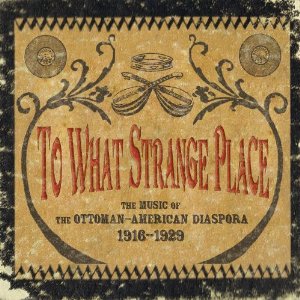To What Strange Place: The Music of the Ottoman-American Diaspora, 1916-1929
 To What Strange Place:Â The Music of the Ottoman-American Diaspora, 1916-1929
To What Strange Place:Â The Music of the Ottoman-American Diaspora, 1916-1929
Various Artists
(Tompkins Square)
This fascinating and entrancing 3-disk release is a boon to record collectors, musicologists, historians, and folk and world music lovers alike. Compiled by Ian Nagoski from a stack of staticky, ancient 78’s, To What Strange Place preserves not only the cultural milieu of Manhattan’s rich early 20th-century immigrant populations, but also connects it back to their native countries.
The first two discs capture ethnic music of staggering breadth, including performances from musicians of Greek, Turkish, Romani, Armenian, Egyptian and Arabic backgrounds. While the music on these discs is split between lighthearted “Dances & Joys” and the more poignant lament “I Wish I Never Came,” for the non-native speaker the pining, intertwining melodies of the latter songs are often indistinguishable from the meandering and mesmerizing jaunts of the former.
Of the many singers and musicians featured, most found a nurturing and nostalgic environment in a few specific neighborhoods in the 30’s, from Lexington Avenue all the way west to 8th Avenue. As Nagoski implies in his scholarly notes, the scene sounds eerily prescient of the cafe-to-club hopscotch played across Greenwich Village during the American folk revival three decades on. For the artists featured here, what they found were not only places to call home, but to help recall home, as well. Some would actually make a living playing music (such as the prolific Marika Papagika, who recorded 200+ songs and even opened her own club); others, like the horribly obscure Shmon Arslan, had only three sides to their names, though their scant output makes their music no less interesting or important. And despite some disparate cultural heritage, there’s a uniformity to the many different-but-similar ethnic modes that makes the case for the umbrella grouping of “Ottoman,” beyond simply the geographic boundaries.
Those boundaries, however heavily imposed, did exist, and so the views of these musicians’ homelands from New York’s shores were fraught with both yearning and spite. Thus, the third disk presents songs that were recorded across the Ottoman empire (dating from as early as 1909) and were released in the U.S., ending up as part of the emigres’ own record collections. While no more authentic than the music on the first two discs, which bear no real trace of Western influence, the songs on “Notes From Home” have a pervasive, faraway feel to them. Included is a cello improvisation by the “Mozart or Jimi Hendrix… of the Ottoman era” (by Nagoski’s account), Cemil Bey; Sufi flute tunes and deep Arabic classical music (all fueled by wanton-sounding cocaine intake); compositions by the Jewish Iraqi master musician Zaki Murad; and a lovely oud-and-vocal sister duet by Lale and Nerkis Hanoum, aptly entitled “I Went to the Garden of the Future.â€
What Nagoski and Tompkins Square have unearthed is a massive treasury of world music roots, providing context, contemplation, and wonder over the course of just a few hours. Informal spins may turn off those who hear these mellifluous and akin folk songs as being too much the same. But diligent listeners will find that the Hanoum sisters’ “Garden of the Future” was a pasture of earthly delights and all-too-human desires, providing reward after reward from this cornucopia of cultures long past.


